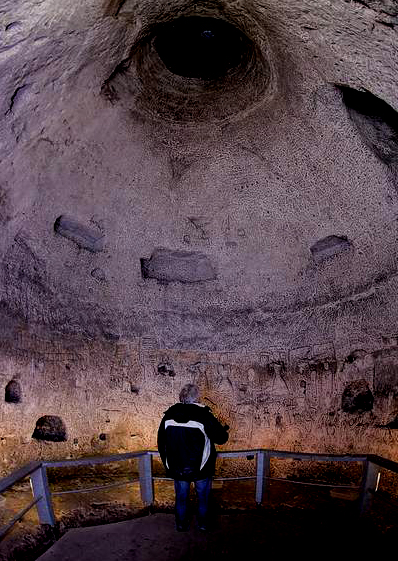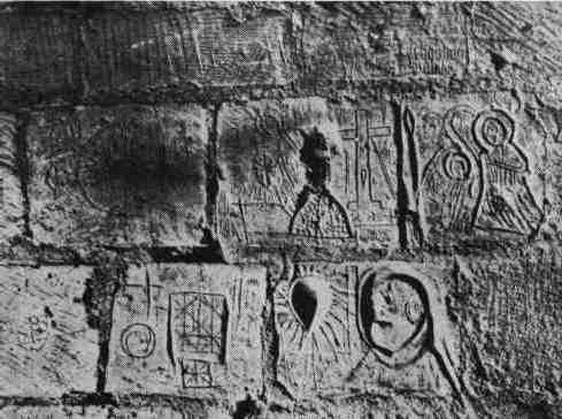It looks like you're using an Ad Blocker.
Please white-list or disable AboveTopSecret.com in your ad-blocking tool.
Thank you.
Some features of ATS will be disabled while you continue to use an ad-blocker.
25
share:
The supposed Templar cave at Royston in England contains a fascinating wealth of symbolism from the period following the banning of the Order in 1307,
the cave containing a date from 40 years later, probably a symbolic period in itself, with biblical precedents.
The cave is considered to have an illustration of the burning at the stake of the Templar Grand Master jacques de Molay, and much more besides.
I'll outline the general information and opinions on this cave, and then provide my own interpretation of the symbols and the mysteries they involve.
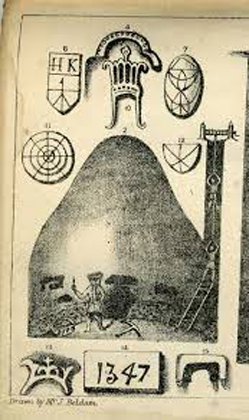
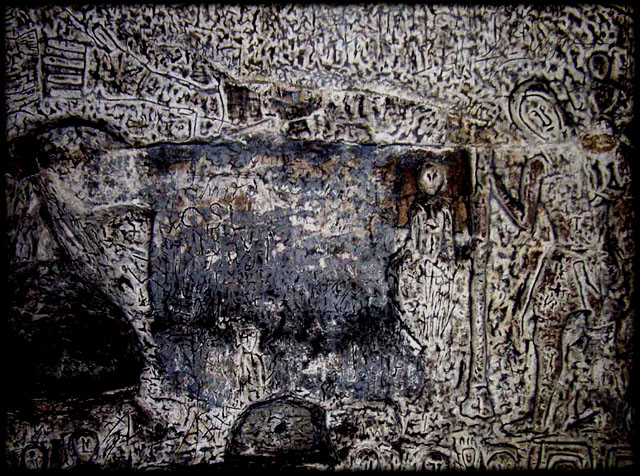
Knights Templar Cave
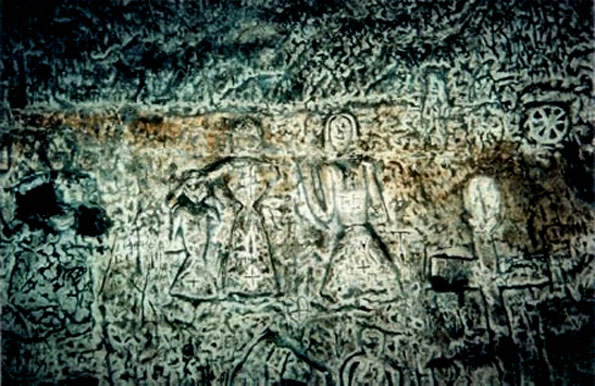
Royston Cave and the Bloodline
Knights Templar Mystery
The oldest illustrations from the cave can provide the best indications of the symbolism, as there has been considerable deterioration and disfigurment subsequently.
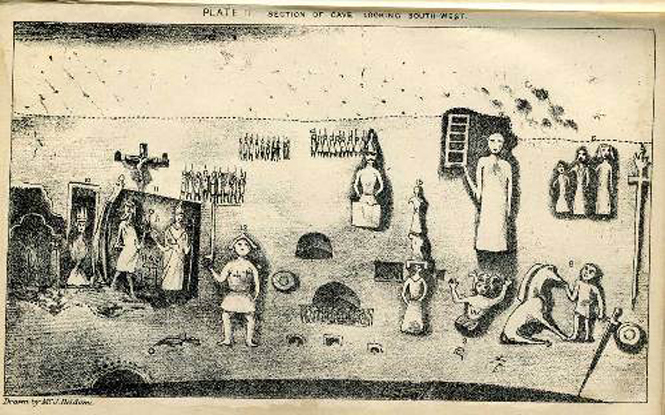
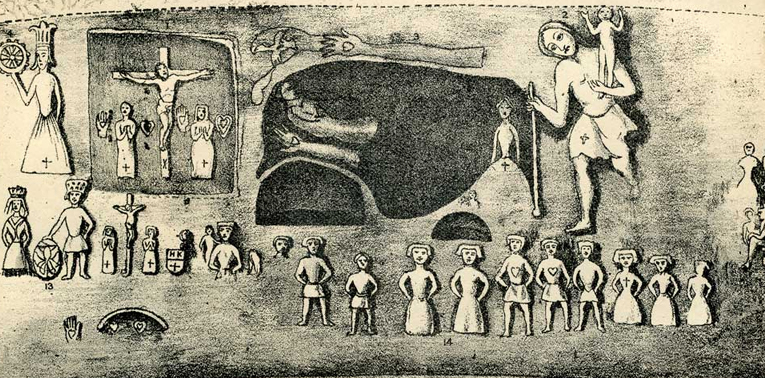
Above one finds centre stage a representation of the Holy Sepulche, containing a seated Mary Magdalene and an enshrouded Jesus, who is curiously resting upon an arm containing a heart within the hand, a curious symbol that is proliferate in the cave, and the one most requiring interpretation.
The carved compartments for relics beneath these figures are also noteworthy.
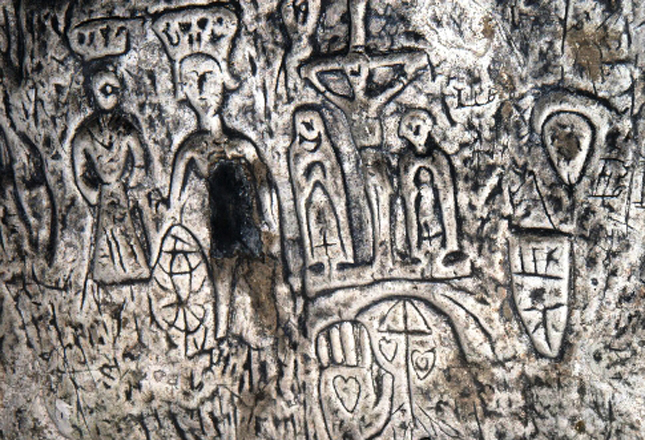
The symbol of the Heart in the Hand is thought to date from the Protestant era and to have been adopted by Calvin, it was popular with the Shakers, Amish, Oddfellows and Masons, but this clearly pre-dates that in a Catholic context.
The only comparison i can make is with eye in the Hand symbolism, were the hand relates to the constellation Orion, and the eye the Nebula, this was widespread in the Near East and elsewhere, i studied it here;
www.abovetopsecret.com...
The likely explanation then is the eye has been replaced with the symbolism of Sacre Couer, that Orion is intended in this symbolism is reinforced by the looming presence of Saint Christopher.
This Saint popular with the Templars was introduced into Christianity from earlier Near Eastern tradition, it's basis is that of Orion in search of the sunrise, a metaphor for hoped for resurrection, the crossing of the river of death toward the other side.
Here's a painting on that theme by Nicholas Poussin, were Artemis reclines in the clouds idly watching;
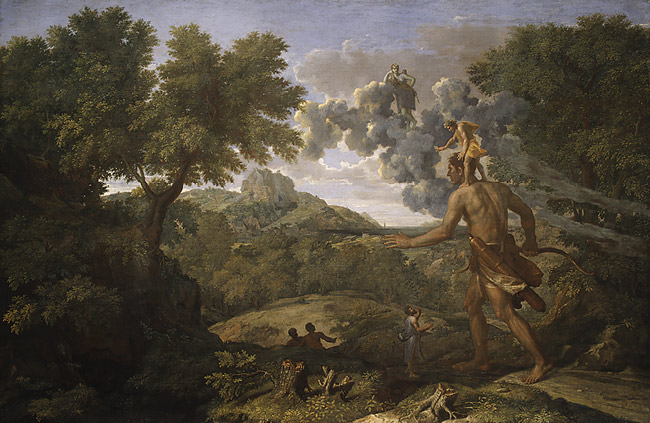
Also we see the dove representing the Holy Spirit associated with the hand above the sepulche, were the Orion Nebula was understood as relating to this sign.
The Orion Nebula had association with first primeval creation and birthing, used in this context the concern is with rebirth.
One should also look to these motifs in the Chinon graffiti;
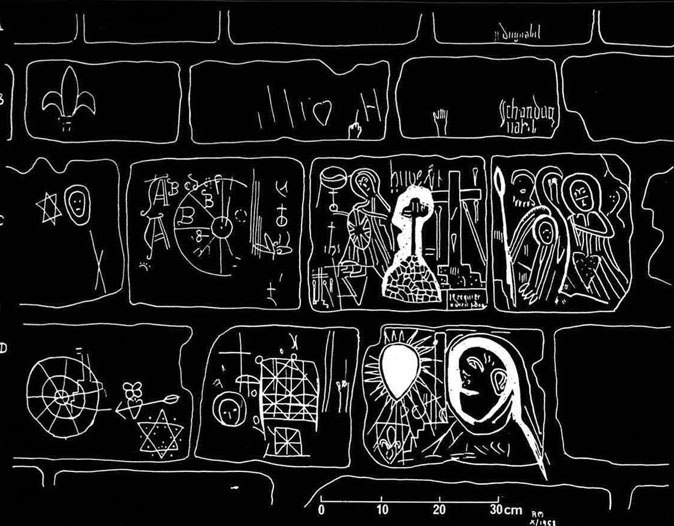
In the garments of the figures we see that the Sacre Couer is interchangeable as it were, with the motif of the cross, which in itself denotes the centre of the four directions, the Heart.
Another favourite Saint of the Templars present is that of Saint Katherine of Egypt, on whose Feast day of November 25th the crusaders had achieved victory over Saladin, her cultic motif of the wheel figures very prominently.
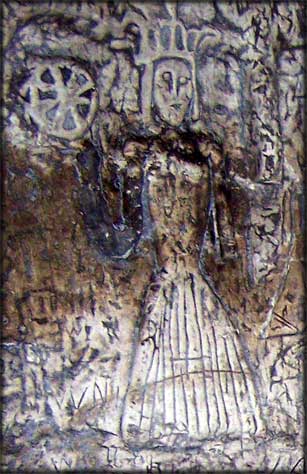
The wheel is the most esoteric looking aspect of the graffiti, the reason being it was associated with the wheel of Ezekiel, the turning of the four faced 'beast', the Lion, ox, eagle and man, which in Christian represented the four Evangelists of the Gospels, Mark, Matthew, Luke and John respectively.
The four beasts of the wheel were understood as relating to the Throne of the Heavens, of God, and contained the Divine Presence within in the manner of the Ark of the Covenant.
How this was conjectured related to the orbital periodics of the planets of the inner solar system, these rounded into figures correspondant to degrees indicative of the four/eight directions, achieved thus;
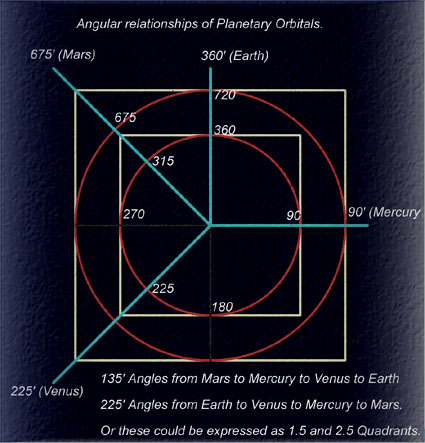
Such is the mystery of those four 'beasts', and how this related to the Ark of the Covenant;
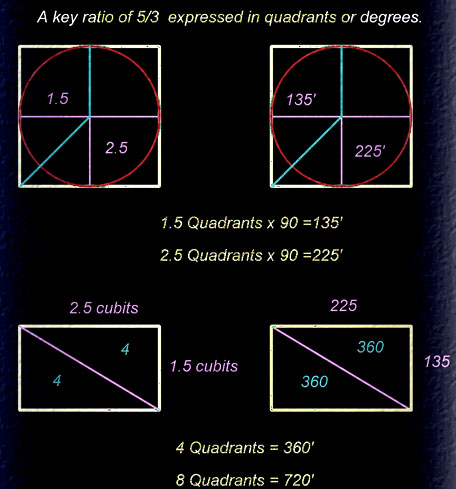
The key arbiter an angle of 225 degrees, based upon the orbital periodic of Venus, our Mistress of the wheel.
There is also seen the geometry related to the twelve gated city of Jerusalem, and the derivative six pointed star.
Another Saint illustrated is Saint Laurence, who was the guardian of the Holy Grail;
He is seen in connection with the gridiron he was burnt upon.
en.wikipedia.org...
The cave is considered to have an illustration of the burning at the stake of the Templar Grand Master jacques de Molay, and much more besides.
I'll outline the general information and opinions on this cave, and then provide my own interpretation of the symbols and the mysteries they involve.

Just below the street, along an alley in a quiet English market town, is an extraordinary survival from the time of the Crusades – a small cave richly carved in saints, knights, warrior monks, crucifixion scenes and folkloric figures more
...a treasurehouse of ancient religious and secular carvings, linked to the Knights Templar. It is one of Britain’s most precious yet least-known medieval sites.
The Royston Cave, a beehive-shaped chamber, extends some 30ft beneath the centre of the Hertfordshire town – tucked away beneath a betting shop. Hewn out of a 180ft thick seam of chalk, the extraordinary medieval survival was uncovered by accident in 1742 during building work. Inside, depictions of biblical scenes and portraits of Christian martyrs were found cut into the chalk walls. than 700 years ago.

Knights Templar Cave
“Royston Cave features the only carving in the world to depict the bloodline of Jesus.

Royston Cave and the Bloodline
The Knights Templar have been credited with carving the Cave as there are many similarities between it and some of their other structures. They built mostly round churches, as in the Temple Church, London, and ‘it’s vertical bell-shape is similar to structures found in Palestine and Czechoslovakia’ (Lord 2004: 81), also, ‘The images as a whole have some similarities with other known Templar carvings at the castle of Chinon and Lincoln’ , and The Templars, including Jacques de Molay, the Grand Master, were imprisoned in the Tower de Coudray, Chateaux de Chinon, France on suppression of the Order, and a panel of graffiti including this symbol [Hebraic quaph] is attributed to these prisoners
This is a possible link to the two sites and the Knights Templar. There is also the Templar symbol of the two knights on a horse depicted in the Cave, but whether this was carved by a Templar or not will probably never be known. But what is widely known is that the Templars built underground passages and used them.
Knights Templar Mystery
The oldest illustrations from the cave can provide the best indications of the symbolism, as there has been considerable deterioration and disfigurment subsequently.


Above one finds centre stage a representation of the Holy Sepulche, containing a seated Mary Magdalene and an enshrouded Jesus, who is curiously resting upon an arm containing a heart within the hand, a curious symbol that is proliferate in the cave, and the one most requiring interpretation.
The carved compartments for relics beneath these figures are also noteworthy.

The symbol of the Heart in the Hand is thought to date from the Protestant era and to have been adopted by Calvin, it was popular with the Shakers, Amish, Oddfellows and Masons, but this clearly pre-dates that in a Catholic context.
The only comparison i can make is with eye in the Hand symbolism, were the hand relates to the constellation Orion, and the eye the Nebula, this was widespread in the Near East and elsewhere, i studied it here;
www.abovetopsecret.com...
The likely explanation then is the eye has been replaced with the symbolism of Sacre Couer, that Orion is intended in this symbolism is reinforced by the looming presence of Saint Christopher.
This Saint popular with the Templars was introduced into Christianity from earlier Near Eastern tradition, it's basis is that of Orion in search of the sunrise, a metaphor for hoped for resurrection, the crossing of the river of death toward the other side.
Here's a painting on that theme by Nicholas Poussin, were Artemis reclines in the clouds idly watching;

Also we see the dove representing the Holy Spirit associated with the hand above the sepulche, were the Orion Nebula was understood as relating to this sign.
The Orion Nebula had association with first primeval creation and birthing, used in this context the concern is with rebirth.
One should also look to these motifs in the Chinon graffiti;

In the garments of the figures we see that the Sacre Couer is interchangeable as it were, with the motif of the cross, which in itself denotes the centre of the four directions, the Heart.
Another favourite Saint of the Templars present is that of Saint Katherine of Egypt, on whose Feast day of November 25th the crusaders had achieved victory over Saladin, her cultic motif of the wheel figures very prominently.

The wheel is the most esoteric looking aspect of the graffiti, the reason being it was associated with the wheel of Ezekiel, the turning of the four faced 'beast', the Lion, ox, eagle and man, which in Christian represented the four Evangelists of the Gospels, Mark, Matthew, Luke and John respectively.
The four beasts of the wheel were understood as relating to the Throne of the Heavens, of God, and contained the Divine Presence within in the manner of the Ark of the Covenant.
How this was conjectured related to the orbital periodics of the planets of the inner solar system, these rounded into figures correspondant to degrees indicative of the four/eight directions, achieved thus;

Such is the mystery of those four 'beasts', and how this related to the Ark of the Covenant;

The key arbiter an angle of 225 degrees, based upon the orbital periodic of Venus, our Mistress of the wheel.
There is also seen the geometry related to the twelve gated city of Jerusalem, and the derivative six pointed star.
Another Saint illustrated is Saint Laurence, who was the guardian of the Holy Grail;
according to lore, Lawrence was able to spirit this away to Huesca, in present day Aragon, with a letter and a supposed inventory, where it lay hidden and unregarded for centuries. When Augustine connects Lawrence with a chalice, it is the chalice of the Mass:
For in that Church, you see, as you have regularly been told, he performed the office of deacon; it was there that he administered the sacred chalice of Christ’s blood.
He is seen in connection with the gridiron he was burnt upon.
en.wikipedia.org...
edit on 20-4-2013 by Kantzveldt because: (no reason given)
reply to post by phantomjack
Maybe, the sepulchre is a curious construction with the inbuilt chambers for relics, but it's the centre piece of the cave shrine and the mysteries involved.
It's interesting that the figures considered to be guardians or descendants are common folk , or at least not famous,to the side were Mary Magdalene is seated whereas on the other side some are recognised as Kings and Queens...
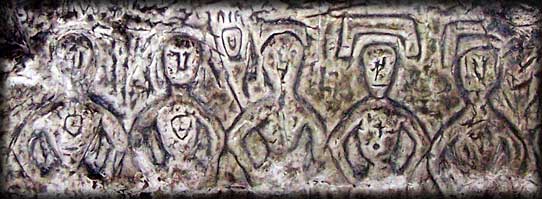

Maybe, the sepulchre is a curious construction with the inbuilt chambers for relics, but it's the centre piece of the cave shrine and the mysteries involved.
It's interesting that the figures considered to be guardians or descendants are common folk , or at least not famous,to the side were Mary Magdalene is seated whereas on the other side some are recognised as Kings and Queens...


edit on 20-4-2013 by Kantzveldt because: (no reason given)
Thanks for that post you may well have given the answer to two of my weirdest dreams.
1st I saw gaps in the clouds and three dots above and below a thick rounded lines.
In Mayan it means 3 above 5 above 3. Or 8 above 3.
2nd The other one, a symbol, appeared twice in two dreams. It looked like Ezekiel's wheel but it was made of mythological characters. Itbwas in the bluest sky
Apollo was in the middle. Zeus was at the North position. NE was unknown wielding a sword.
East, SE and South were 3 magicians; a chinese, Nostradamus and an old man with a long wispy moustache.
SW, West and NW were beasts; Mithras, Minotaur and another bull with embrossed writing on its side.
They then moved into another pattern; the 3 mythological beings on top. 3 Magicians were in the middle and the bulls beasts the lowest 3.
I'm a bit closer than before, thanks.
1st I saw gaps in the clouds and three dots above and below a thick rounded lines.
In Mayan it means 3 above 5 above 3. Or 8 above 3.
2nd The other one, a symbol, appeared twice in two dreams. It looked like Ezekiel's wheel but it was made of mythological characters. Itbwas in the bluest sky
Apollo was in the middle. Zeus was at the North position. NE was unknown wielding a sword.
East, SE and South were 3 magicians; a chinese, Nostradamus and an old man with a long wispy moustache.
SW, West and NW were beasts; Mithras, Minotaur and another bull with embrossed writing on its side.
They then moved into another pattern; the 3 mythological beings on top. 3 Magicians were in the middle and the bulls beasts the lowest 3.
I'm a bit closer than before, thanks.
Very interesting. For being a Templar nerd I had never researched this. When I'm home from my travels I will read this further.
reply to post by AriesJedi
Glad you found some insight, the eight directional arrangement is according to numeric balance;
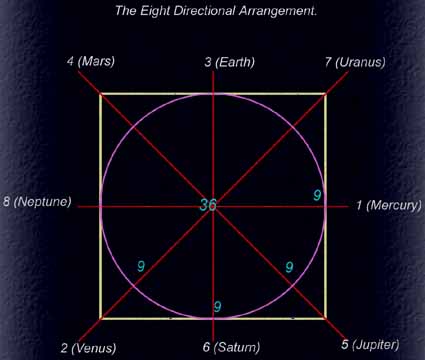
Were that is seen to work best, perhaps not unsurprisingly, is in the Heart of Britannia, it determines the directional spiritual influences that rule the land.
For example, the principle of Government is in the South East, the rule of Jupiter, the most passionate and warlike people are to the North East, in Ulster ruled by Mars, the South West is a region of mystery and beauty, in the South are the ancient mysteries that transcend time and decay such as Stonehenge...so it is understood as a functional magical schemata on the grand scale, and is the cult of Ai-pol, the high searcher in Gaelic, or Apollo to the Greeks.
Apollo is thus concerned with the central axis to the highest point, Polaris, extending upward from Crux in the Southern hemisphere, and also extending the eight spiritual aspects across the entire Earth...with the help of Artemis.
Apollo as light bringer then associate with the Sun, and Artemis his reflected counterpart, the Moon.
In search of sunrise;
reply to post by KSigMason
Well it's all there for any Templar nerd, one thing i forgot to mention is the association of the sword symbol with grave, particularly Neoltihc passage graves, were the sun would penetrate down the narrow passage at winter solstice.
Glad you found some insight, the eight directional arrangement is according to numeric balance;

Were that is seen to work best, perhaps not unsurprisingly, is in the Heart of Britannia, it determines the directional spiritual influences that rule the land.
For example, the principle of Government is in the South East, the rule of Jupiter, the most passionate and warlike people are to the North East, in Ulster ruled by Mars, the South West is a region of mystery and beauty, in the South are the ancient mysteries that transcend time and decay such as Stonehenge...so it is understood as a functional magical schemata on the grand scale, and is the cult of Ai-pol, the high searcher in Gaelic, or Apollo to the Greeks.
Apollo is thus concerned with the central axis to the highest point, Polaris, extending upward from Crux in the Southern hemisphere, and also extending the eight spiritual aspects across the entire Earth...with the help of Artemis.
Apollo as light bringer then associate with the Sun, and Artemis his reflected counterpart, the Moon.
In search of sunrise;
reply to post by KSigMason
Well it's all there for any Templar nerd, one thing i forgot to mention is the association of the sword symbol with grave, particularly Neoltihc passage graves, were the sun would penetrate down the narrow passage at winter solstice.
edit on 21-4-2013 by Kantzveldt because: (no reason given)
Wow that was amazing information.
Do you take apprentices?
The only thing I have worked out that is a secret of the Templars is; table round, table square and table rectangle, made of stone and adds up to 21.
Stonehenge, pyramid and Solomon's temple all made of stone and I forget the 21 but it is to do with the leylines and Holy grail.
That was the start of my journey over 4 years ago.
Do you take apprentices?
The only thing I have worked out that is a secret of the Templars is; table round, table square and table rectangle, made of stone and adds up to 21.
Stonehenge, pyramid and Solomon's temple all made of stone and I forget the 21 but it is to do with the leylines and Holy grail.
That was the start of my journey over 4 years ago.
reply to post by AriesJedi
The 21 thing is just a continuation of your numeric sequence, the Fibonacci series, 3,5,8,13,21.
The concern there is again with a ratio relationship between the orbital periodics of Venus and the Earth, over an 8 year period, were Venus will have gone through 13 orbits, and in doing so risen at 5 points around the horizon, giving the symbols of the pentagram.
The Pentagonal ideogram is based upon the movements of the Planet Venus as viewed from Earth, what basically occurs is that the planet will appear at five seperate points in the sky over an eight year period, as each of the point appearances takes place over 584 days, this multiplied by the five points to give 5 x 584=2,920, which divides 2,920/8=365.
Thus the cycle is one of eight Earth orbits/years, but over the 2,920 days the planet Venus will have undertaken thirteen orbits, as her orbital period is around 224.6 (Earth) days in duration, so 2,920/13=224.6...which gives as a basis for the Earth-Venus relationship the fact that One cycle=8 Earth orbits or 13 Venus orbits.
Cycles = Earth years =Venus orbits =(Earth+Venus) =(Venus-Earth)
1..............8...................13.......................21...................5
5.............40..................65.....................105..................25
10............80..................130....................210..................50
There's also a corpus of esoteric numerics derivative from this, which was associate with stepped pyramid progression, it involves sum of integers formulation, were if you want to know the sum value of any number you add 1 and multiply by half, for example the sum of intergers of 20 is 210, were 10 x 21 =210
This can be set out thus;
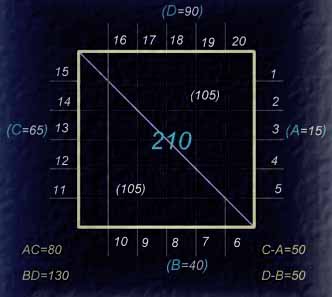
(AC=80)& (BD=130)
80 Earth orbits =130 orbits of Venus.
Sum=210
(A+B+C+D=210)
Differential=50
(C-A=50) & (D-B=50)
t can be seen therefore how the sum of intergers of 20 set thus relates well to the key figures of the Earth/Venus cycle, and also therefore to the design of the Great Pyramid, as this is 210 sandstone masonry courses in height (ABCD), has shafts leading toward the 90th level (D) from the 'Queens Chamber' and shafts leading toward the 105th level (B+C)&(A+D) from the 'Kings Chamber' the respective chambers are set on the 25th course (D-C) and (B-A) and upon the 50th course (C-A) & (D-B).
The exact same figures can also be read off a numeric arrangement of five inlaid squares, with the sum of intergers of 4,12,20,28,36 set around them, a concept that if presented in 3D form would of course present itself as a simple stepped monument, such as the pyramid ideology was based upon.
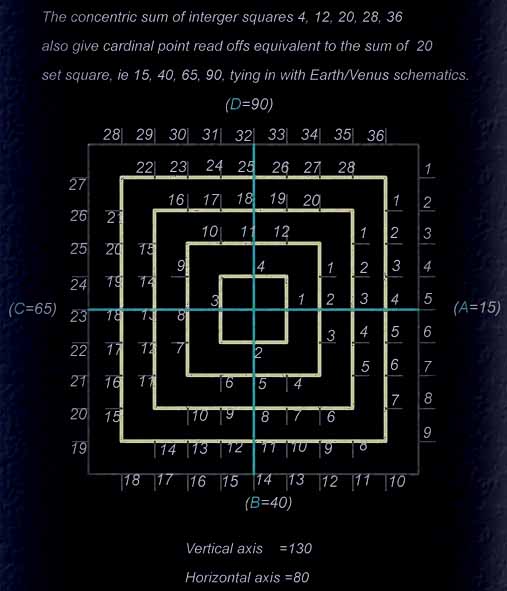
It's a concern basically with pattern and harmonies within numerics that are reflected in the Heavens in terms of the Earth-Venus orbital relationships, and how these can be set four square and represented by the pyramid.
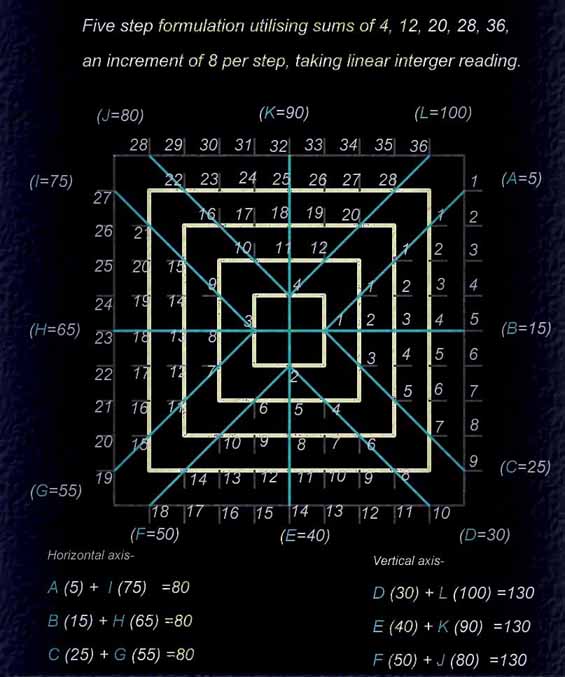
So that's your 21....the apprentice by the way, to the Cult of Apollo-Artemis was Hermes/Mercury, he stole some of his cattle as it were, established the Hermetic Tradition.
The 21 thing is just a continuation of your numeric sequence, the Fibonacci series, 3,5,8,13,21.
The concern there is again with a ratio relationship between the orbital periodics of Venus and the Earth, over an 8 year period, were Venus will have gone through 13 orbits, and in doing so risen at 5 points around the horizon, giving the symbols of the pentagram.
The Pentagonal ideogram is based upon the movements of the Planet Venus as viewed from Earth, what basically occurs is that the planet will appear at five seperate points in the sky over an eight year period, as each of the point appearances takes place over 584 days, this multiplied by the five points to give 5 x 584=2,920, which divides 2,920/8=365.
Thus the cycle is one of eight Earth orbits/years, but over the 2,920 days the planet Venus will have undertaken thirteen orbits, as her orbital period is around 224.6 (Earth) days in duration, so 2,920/13=224.6...which gives as a basis for the Earth-Venus relationship the fact that One cycle=8 Earth orbits or 13 Venus orbits.
Cycles = Earth years =Venus orbits =(Earth+Venus) =(Venus-Earth)
1..............8...................13.......................21...................5
5.............40..................65.....................105..................25
10............80..................130....................210..................50
There's also a corpus of esoteric numerics derivative from this, which was associate with stepped pyramid progression, it involves sum of integers formulation, were if you want to know the sum value of any number you add 1 and multiply by half, for example the sum of intergers of 20 is 210, were 10 x 21 =210
This can be set out thus;

(AC=80)& (BD=130)
80 Earth orbits =130 orbits of Venus.
Sum=210
(A+B+C+D=210)
Differential=50
(C-A=50) & (D-B=50)
t can be seen therefore how the sum of intergers of 20 set thus relates well to the key figures of the Earth/Venus cycle, and also therefore to the design of the Great Pyramid, as this is 210 sandstone masonry courses in height (ABCD), has shafts leading toward the 90th level (D) from the 'Queens Chamber' and shafts leading toward the 105th level (B+C)&(A+D) from the 'Kings Chamber' the respective chambers are set on the 25th course (D-C) and (B-A) and upon the 50th course (C-A) & (D-B).
The exact same figures can also be read off a numeric arrangement of five inlaid squares, with the sum of intergers of 4,12,20,28,36 set around them, a concept that if presented in 3D form would of course present itself as a simple stepped monument, such as the pyramid ideology was based upon.

It's a concern basically with pattern and harmonies within numerics that are reflected in the Heavens in terms of the Earth-Venus orbital relationships, and how these can be set four square and represented by the pyramid.

So that's your 21....the apprentice by the way, to the Cult of Apollo-Artemis was Hermes/Mercury, he stole some of his cattle as it were, established the Hermetic Tradition.
reply to post by Kantzveldt
Very interesting read. I found this informative and well written. Thank you for bringing the site to our attention. Another great find imho.
S & F
Very interesting read. I found this informative and well written. Thank you for bringing the site to our attention. Another great find imho.
S & F
reply to post by SLAYER69
Thanks, the symbolism involved in this cave has been largely overlooked and the Templar interest in particular Saints under appreciated.
Thanks, the symbolism involved in this cave has been largely overlooked and the Templar interest in particular Saints under appreciated.
Very interesting stuff. I especially liked learning that how the Grail became confused with a representation of the Chalice seen most recently in all
the treasure hunt adventure movies.
So in fact, the Chalice is used to represent where the Holy Grail had gone to. If you wonder, just remember that Pope Sixtus used to be a priest in Spain, whose modest Deacon attended to modest tasks such as preparing the Chalice for service. Hence the Chalice symbolizing the Deacon who scurried away the Holy Grail into safety, protecting it from Emperor Valerian who sought to seize it along with the other treasures of the Church. The Grail therefore is NOT a cup, but something entirely different.
Beyond this interesting information brought to us courtesy of Wikipedia's sometimes fascinating entries, we can also ask ourselves if there weren't other things discovered by the crusaders and brought back by the Knights Templar. I happen to see in the Royston cave what appears to very closely resemble a Reptilian creature, showing that the Templars may have discovered Alien technology in Solomon's Temple such as the Ark of the Covenant, and also possibly information about our origins and extraterrestrial intervention in more ancient times.
Reptilian Entity seen above the High Priest at minutes 3:40 and 7:02
This creature definitely looks Reptilian and seems be wearing a Pope's garb, sitting atop a throne like a divinity. He carries a technological apparatus or weapon in his right hand, which might have served as the inspiration for the Sceptres used in later centuries by Kings to symbolize their power? What he is holding in his left hand is not readily recognizable in the video, if you have any ideas, let us know! It would be interesting to locate photos which show this in more detail. The person filming this clearly didn't know what to focus on. Interestingly, for some reason this creature was not represented in the drawings of the caves drafted in earlier times.
Getsmart
Holy Chalice
According to lore, Lawrence was able to spirit this away to Huesca, in present day Aragon, with a letter and a supposed inventory, where it lay hidden and unregarded for centuries. When Augustine connects Lawrence with a chalice, it is the chalice of the Mass:
For in that Church, you see, as you have regularly been told, he performed the office of deacon; it was there that he administered the sacred chalice of Christ’s blood.
—[citation needed]
According to Catholic tradition the Holy Grail is a relic that was sent by St Lawrence to his parents in northern Aragon. He entrusted this sacred chalice to a friend whom he knew would travel back to Huesca, remaining in the monastery of San Juan de la Peña, core of spiritual strength for the emerging kingdom of Aragon. While the Holy Chalice's exact journey through the centuries is disputed, it is generally accepted by Catholics that the Chalice was sent by his family to this monastery for preservation and veneration. Historical records indicate that this chalice has been venerated and preserved by a number of monks and monasteries through the ages. Today the Holy Grail is venerated in a special chapel in the Catholic Cathedral of Valencia, Spain.
Wikipedia: Laurence of Rome
So in fact, the Chalice is used to represent where the Holy Grail had gone to. If you wonder, just remember that Pope Sixtus used to be a priest in Spain, whose modest Deacon attended to modest tasks such as preparing the Chalice for service. Hence the Chalice symbolizing the Deacon who scurried away the Holy Grail into safety, protecting it from Emperor Valerian who sought to seize it along with the other treasures of the Church. The Grail therefore is NOT a cup, but something entirely different.
Beyond this interesting information brought to us courtesy of Wikipedia's sometimes fascinating entries, we can also ask ourselves if there weren't other things discovered by the crusaders and brought back by the Knights Templar. I happen to see in the Royston cave what appears to very closely resemble a Reptilian creature, showing that the Templars may have discovered Alien technology in Solomon's Temple such as the Ark of the Covenant, and also possibly information about our origins and extraterrestrial intervention in more ancient times.
Reptilian Entity seen above the High Priest at minutes 3:40 and 7:02
This creature definitely looks Reptilian and seems be wearing a Pope's garb, sitting atop a throne like a divinity. He carries a technological apparatus or weapon in his right hand, which might have served as the inspiration for the Sceptres used in later centuries by Kings to symbolize their power? What he is holding in his left hand is not readily recognizable in the video, if you have any ideas, let us know! It would be interesting to locate photos which show this in more detail. The person filming this clearly didn't know what to focus on. Interestingly, for some reason this creature was not represented in the drawings of the caves drafted in earlier times.
Getsmart
I am a huge Templar fan, but no expert. I try to pick up and understand the information as best that I can, but the people on this site, should hold
lectures! wow. this site's never dull!
Thanks for the post OP!
oh yea, I was curious, it seems that the Templars had numerous crosses that they used to represent themselves, can anyone tell me or show me which in fact was the True Templar Cross or symbol they used?
I appreciate any help.
Cheers.
Thanks for the post OP!
oh yea, I was curious, it seems that the Templars had numerous crosses that they used to represent themselves, can anyone tell me or show me which in fact was the True Templar Cross or symbol they used?
I appreciate any help.
Cheers.
hi guys.
it seems i'm developing a gift for "transitive inference" or information topology based on heightened visual acuity.
i; being a moral person of high character and principle, seek to apply any "gift" in a "constructive" manner with "positive" outcomes beneficial to man.
i prefer thinkers to followers, builders to destroyers, and peace-seekers to war-mongers.
i will examine the material posted. if i can contribute i will.
Request. please, where possible, provide high-resolution images (not limited by forum constraints; i.e., use 3rd party image hosting like Imageshack 1600 x 1200 resolution)
Also, i want factual information; not opinion (provide original resource citations/links)
opinion is like the anal opening.
likewise; i am neutral; no political rhetoric.
i will not associate with "haters" with an agenda. i stress this; so, any interested parties make note of this.
my duty of fidelity is with God; and God only.
open your heart.
much Love, Light, Charity, Restraint, Discernment, Wisdom
ezrin
it seems i'm developing a gift for "transitive inference" or information topology based on heightened visual acuity.
i; being a moral person of high character and principle, seek to apply any "gift" in a "constructive" manner with "positive" outcomes beneficial to man.
i prefer thinkers to followers, builders to destroyers, and peace-seekers to war-mongers.
i will examine the material posted. if i can contribute i will.
Request. please, where possible, provide high-resolution images (not limited by forum constraints; i.e., use 3rd party image hosting like Imageshack 1600 x 1200 resolution)
Also, i want factual information; not opinion (provide original resource citations/links)
opinion is like the anal opening.
likewise; i am neutral; no political rhetoric.
i will not associate with "haters" with an agenda. i stress this; so, any interested parties make note of this.
my duty of fidelity is with God; and God only.
open your heart.
much Love, Light, Charity, Restraint, Discernment, Wisdom
ezrin
reply to post by Kantzveldt
Fascinating. I'm not entirely sure what to make of it. The carvings seem to be the work of a single person, and there is a disorder to them that implies a none too stable mind. It has a distinct air of obsession or fanaticism.
I am wondering if this was some kind of hermitage, or if someone was imprisoned, or hidden there.
Very, very interesting none the less.
Fascinating. I'm not entirely sure what to make of it. The carvings seem to be the work of a single person, and there is a disorder to them that implies a none too stable mind. It has a distinct air of obsession or fanaticism.
I am wondering if this was some kind of hermitage, or if someone was imprisoned, or hidden there.
Very, very interesting none the less.
reply to post by ezrin
Hi ezrin.
I'm so glad that you asked for it.
**Also, i want factual information; not opinion (provide original resource citations/links)**
No one around here seems to care about that anymore.
Or maybe they take the ATS moto to seriously...
And I liked this best...
**opinion is like the anal opening.**
I've been following this thread from the beginning since I thought it could lead to some interesting info...
But Kant seems to be to busy with pushing biased info on her "pet-themes" so let me help you with that.
First of all the cave is not sooo secret at all - they have their own www. site...
www.roystoncave.co.uk...
...where they stand back from attributing the carvings to the Knights Templar evidently - with good reason.
This was a "pet-project" of Sylvia Beamon, a local archaeologist, who made this idea popular in the 1970ies.
There is a Wiki page...
en.wikipedia.org...
And - of course - a Bad Archeology article which I found sooo much more interesting than this "Kantilevered info".
www.badarchaeology.com...
Not so much "sensation" - like Kant wants you to believe - but still a mystery in his own right.
Now you might ask why Kant didn't provide those links because they contain "some" factual information.
I have asked this myself and had some discussions with her.
I came to the conclusion that stars and flags are more valuable to some people than real knowledge.
But that's only my opinion - and we know what this is like... ...don't we?
Naturally that would also be my approach in the hole.
I hope that I have been of service.
A
Hi ezrin.
I'm so glad that you asked for it.
**Also, i want factual information; not opinion (provide original resource citations/links)**
No one around here seems to care about that anymore.
Or maybe they take the ATS moto to seriously...
And I liked this best...
**opinion is like the anal opening.**
I've been following this thread from the beginning since I thought it could lead to some interesting info...
But Kant seems to be to busy with pushing biased info on her "pet-themes" so let me help you with that.
First of all the cave is not sooo secret at all - they have their own www. site...
www.roystoncave.co.uk...
...where they stand back from attributing the carvings to the Knights Templar evidently - with good reason.
This was a "pet-project" of Sylvia Beamon, a local archaeologist, who made this idea popular in the 1970ies.
There is a Wiki page...
en.wikipedia.org...
And - of course - a Bad Archeology article which I found sooo much more interesting than this "Kantilevered info".
www.badarchaeology.com...
Not so much "sensation" - like Kant wants you to believe - but still a mystery in his own right.
Now you might ask why Kant didn't provide those links because they contain "some" factual information.
I have asked this myself and had some discussions with her.
I came to the conclusion that stars and flags are more valuable to some people than real knowledge.
But that's only my opinion - and we know what this is like... ...don't we?
Naturally that would also be my approach in the hole.
I hope that I have been of service.
A
Originally posted by Kantzveldt
The supposed Templar cave at Royston in England
It had nothing to do with the Templars....
It has recently been speculated that it was used by the Knights Templar, who founded nearby Baldock, but this is unlikely, despite its enormous popular appeal. It is more likely that it originated as a cell for anchorites from the nearby Augustinian Priory, although a recent suggestion is that it was the town's earliest prison, perhaps dating from the late fifteenth century
However, as the image has been repaired in modern times, this cannot be confirmed. In 1953, the architectural historian, Nikolaus Pevsner, wrote that the date of the carvings "is hard to guess. They have been called Anglo-Saxon, but are more probably of various dates between the C14 and C17 (the work of unskilled men)".[2] This would place the carvings after the time of the Templars; certainly the figures in armour are wearing full plate, which would date them to a century after the Templars' demise.
reply to post by Kantzveldt
Thanks OP, great catch.
If the bloodline of Jesus is considered to heretical, then of course the church would come up with other ridiculous explanations for the buried chamber - like it was a prison or something illogical like that. It is tough to build underground these days, it is laughable to think the ancient townfolk would go to the trouble as building something so difficult as just a prison underground, when it would be 1000x times easier to build it aboveground.
Yes, of course I realize there are dungeons in castles, but a dungeon in a castle is completely different from a prison buried underneath the middle of town.
The fact that someone/organization is so obviously grasping at straws to come up with these ridiculous alternatives shows how much they are afraid of the information in this chamber.
Thanks OP, great catch.
If the bloodline of Jesus is considered to heretical, then of course the church would come up with other ridiculous explanations for the buried chamber - like it was a prison or something illogical like that. It is tough to build underground these days, it is laughable to think the ancient townfolk would go to the trouble as building something so difficult as just a prison underground, when it would be 1000x times easier to build it aboveground.
Yes, of course I realize there are dungeons in castles, but a dungeon in a castle is completely different from a prison buried underneath the middle of town.
The fact that someone/organization is so obviously grasping at straws to come up with these ridiculous alternatives shows how much they are afraid of the information in this chamber.
reply to post by Ansar
Hello Ansar, accusing me of all sorts as usual...!!!
Anyway, the climactic revelation of your 'debunking page'...
Now that's why i chose to look at particularaties, the heart and the hand. which was the Heraldic charger of the Davidsons of Scotland...Templars.
The Cross Patee or Formy found in some Davidson and Davison arms
was also used by other families. Sometimes this motif associated with
the Knights Templars.
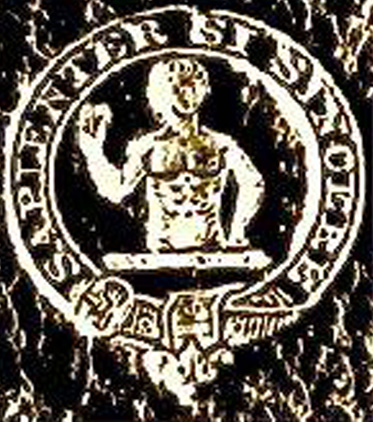
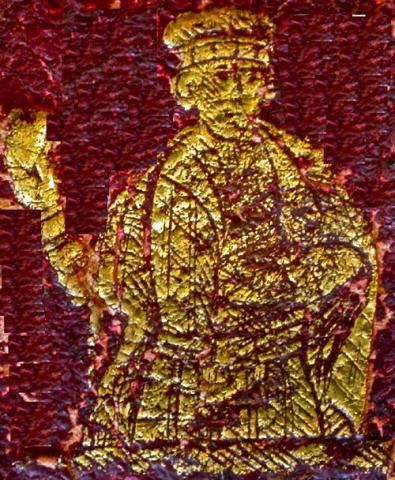
en.wikipedia.org...
Why waste time on the worthless opinions of those who haven't even considered the symbols involved...?
Much castigation, exercise devout;
For here's a young and sweating devil here,
That commonly rebels. 'Tis a good hand,
A frank one.
DESDEMONA
You may, indeed, say so;
For 'twas that hand that gave away my heart.
OTHELLO
A liberal hand. The hearts of old gave hands;
But our new heraldry is hands, not hearts
reply to post by PlanetXisHERE
They propose alternatives without even considering the symbolism involved, which is of an unusual and particular nature, it's just shallow contrariness...and yes pretty desperate behaviour.
Hello Ansar, accusing me of all sorts as usual...!!!
Anyway, the climactic revelation of your 'debunking page'...
Next, Sylvia Beamon set about finding parallels for the carvings at Royston. She found that after the arrest of Templar knights in 1308, a group held in the Donjon du Coudray at the Château at Chinon (Indre et Loire, France) is said to have carved figures on the limestone walls of their prison. She claims close similarities between these graffiti and the carvings at Royston. However, they are far from impressive, as a comparison of the two shows; any similarity is perhaps more likely to be a result of the dates of the two sets of carvings rather than their origin in the symbols of a specific religious order.
Now that's why i chose to look at particularaties, the heart and the hand. which was the Heraldic charger of the Davidsons of Scotland...Templars.
The Cross Patee or Formy found in some Davidson and Davison arms
was also used by other families. Sometimes this motif associated with
the Knights Templars.


he Knights Templar had considerable possessions in the County of Nairn, or Moray, in 1296. The following extract is taken from The History of Nairn: "...There is a writ extant granted in their [the Knights Templar] favour at Berwick, addressed to the Sheriff of Invernairn to put them in possession of their lands, they having made submission to Edward I. This was no doubt done. From the deed of conveyance of the Temple lands in the North from Lord Torphichen, the last Master of the Order, it appears that the following were the lands held here "Those two roods of arable land lying within the territory of the Burgh of Nairn, in that part thereof called [blank] possessed by John Rose, burgess of Nairn, and his sub-tenants; those two roods of arable temple land and house lying within the said territory of Nairn, possessed by Hew Rose of Kilravock and his sub-tenants; all and haill those our temple lands called the lands of Pitfundie lying in the said Sheriffdom of Nairn, betwixt the strype that conies from the lands of Brodie on the east, the fludder or myre upon the south side of the common muir called the Hardmuir Map on the south side, the lands of Penick Map and wood of Lochloy Map on the west, and the Euchcarse of Culbyn on the north, for the most part possessed by the lairds of Brodie, and their sub-tenants." They had also lands at Ardersier Map, which are designated in old charters as Temple Land, Temple Cruik, Temple Bank, Bogschand. They lay partly in the vicinity of the town of Ardersier, between Connage Map and the sea, and between Flemington and the sea. A charter granted at Nairn refers to the locus trialis at Ardersier, doubtless an ancient place of trial by "wager of battle." The Temple lands of Ardersier were held by Davidsons and Mackays as portioners.
en.wikipedia.org...
Why waste time on the worthless opinions of those who haven't even considered the symbols involved...?
Much castigation, exercise devout;
For here's a young and sweating devil here,
That commonly rebels. 'Tis a good hand,
A frank one.
DESDEMONA
You may, indeed, say so;
For 'twas that hand that gave away my heart.
OTHELLO
A liberal hand. The hearts of old gave hands;
But our new heraldry is hands, not hearts
reply to post by PlanetXisHERE
They propose alternatives without even considering the symbolism involved, which is of an unusual and particular nature, it's just shallow contrariness...and yes pretty desperate behaviour.
edit on 1-5-2013 by Kantzveldt because: (no reason given)
edit on 1-5-2013
by Kantzveldt because: (no reason given)
new topics
-
Shane Gillis commercial
Jokes, Puns, & Pranks: 2 hours ago -
Elon Says It’s ‘Likely’ He Buys Tanking MSNBC
Political Ideology: 4 hours ago -
Montelukast affects brain, caused 5 year old to attempt suicide
Medical Issues & Conspiracies: 5 hours ago -
Jaguar Rebrand Video Causes "WTF?" Moment - Seriously Weird
Automotive Discussion: 7 hours ago -
Let's start a conspiracy
General Conspiracies: 8 hours ago -
What Joe Rogan said Vs The View
Dissecting Disinformation: 11 hours ago
top topics
-
Biden's "Reckless" Decision To Escalate Russia-Ukraine War
World War Three: 12 hours ago, 16 flags -
Jaguar Rebrand Video Causes "WTF?" Moment - Seriously Weird
Automotive Discussion: 7 hours ago, 14 flags -
Elon Says It’s ‘Likely’ He Buys Tanking MSNBC
Political Ideology: 4 hours ago, 14 flags -
Montelukast affects brain, caused 5 year old to attempt suicide
Medical Issues & Conspiracies: 5 hours ago, 12 flags -
What Joe Rogan said Vs The View
Dissecting Disinformation: 11 hours ago, 11 flags -
Shane Gillis commercial
Jokes, Puns, & Pranks: 2 hours ago, 3 flags -
Let's start a conspiracy
General Conspiracies: 8 hours ago, 1 flags
active topics
-
Elon Says It’s ‘Likely’ He Buys Tanking MSNBC
Political Ideology • 61 • : TruthJava -
Here is why Western leaders in NATO have zero fear of nuclear warfare. At all. Zero.
World War Three • 8 • : tomeville -
The Acronym Game .. Pt.4
General Chit Chat • 979 • : JJproductions -
What Joe Rogan said Vs The View
Dissecting Disinformation • 20 • : watchitburn -
Is Russia Using a New Type of Beam Weapon Against Ukraine?
Weaponry • 22 • : Zaphod58 -
Putin will warn civilians in targeted areas
World War Three • 48 • : annonentity -
Montelukast affects brain, caused 5 year old to attempt suicide
Medical Issues & Conspiracies • 6 • : RazorV66 -
Well, here we go red lines crossed Biden gives the go ahead to use long range missiles
World War Three • 326 • : yuppa -
Well we know Putins ICBMs won't fail in their silos
World War Three • 171 • : yuppa -
Jaguar Rebrand Video Causes "WTF?" Moment - Seriously Weird
Automotive Discussion • 16 • : BeyondKnowledge3
25

